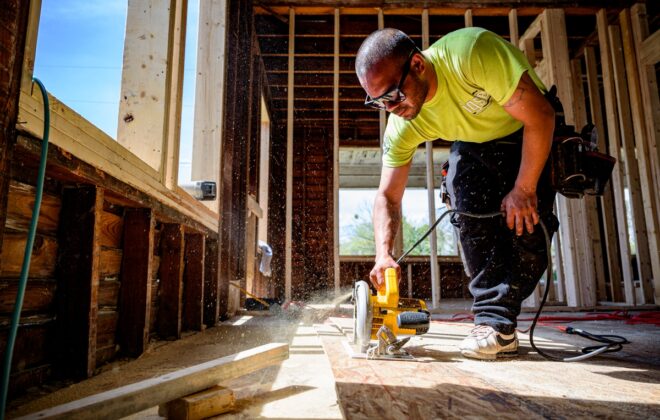10 Must-Have Tools for the Modern Custom Woodworker
Woodworking is a craft that has been around for centuries, and it continues to captivate people with its beauty and craftsmanship. Whether you’re a professional woodworker or a DIY enthusiast, having the right tools is crucial to achieving excellent results. In this article, we will explore the top 10 must-have tools for the modern custom woodworker. From measuring and cutting to shaping and finishing, these tools will empower you to bring your woodworking projects to life. So, let’s dive in!
The Power of Precision: Measuring Tools
Tape Measure
A tape measure is an indispensable tool for any woodworker. It allows you to take accurate measurements of wood pieces, ensuring precise cuts and fittings. Look for a tape measure with a sturdy lock and a clear, easy-to-read scale. With a tape measure in hand, you’ll never have to worry about getting the dimensions wrong.
Combination Square
When it comes to achieving square and precise cuts, a combination square is your best friend. It consists of a ruler and a sliding head that can be locked at different angles, allowing you to mark 90-degree and 45-degree angles accurately. This versatile tool is essential for ensuring your woodworking projects are perfectly aligned.
Digital Caliper
For the utmost precision in measuring small details and tolerances, a digital caliper is a game-changer. It provides accurate readings in both metric and imperial units and is ideal for measuring the thickness of stock, the depth of grooves, and the diameter of holes. Invest in a high-quality digital caliper to elevate the accuracy of your woodworking projects.
Cutting with Confidence: Essential Saws
Circular Saw
The circular saw is a powerhouse tool that every woodworker should have in their arsenal. Its versatility allows for straight cuts, bevel cuts, and even plunge cuts. With a sharp blade and a stable grip, the circular saw can effortlessly slice through various wood materials, making it perfect for projects that require long, straight cuts.
Jigsaw
When it comes to intricate curves and shapes, the jigsaw is the go-to tool. It features a narrow blade that moves up and down rapidly, allowing you to maneuver through tight turns and detailed patterns. Whether you’re creating artistic designs or cutting out shapes, the jigsaw will be your faithful companion.
Miter Saw
The miter saw, also known as a chop saw, is a must-have tool for making accurate crosscuts and miter cuts. It features a rotating circular blade mounted on a pivoting arm, which can be adjusted to achieve precise angles. With a miter saw, you can effortlessly create perfectly angled cuts for picture frames, moldings, and other decorative elements.
Shaping the Future: Tools for Carving and Shaping
Wood Chisels
Wood chisels are indispensable tools for carving and shaping wood. They come in various sizes and shapes, allowing you to create intricate details and smooth surfaces. Whether you’re carving intricate designs or paring away excess material, a set of sharp wood chisels will help you achieve the desired results.
Spokeshave
The spokeshave is a specialized tool used for shaping curved surfaces and smoothing concave or convex shapes. It consists of a blade housed in a metal body with handles on both ends. The spokeshave allows for controlled, precise cuts, making it an excellent choice for shaping chair legs, handles, and other curved components.
Router
The router is a versatile power tool that every woodworker should have in their workshop. It is used for hollowing out areas, creating decorative edges, and shaping wood profiles. With various router bits available, you can achieve a wide range of shapes and designs. Whether you’re making grooves, dadoes, or intricate patterns, the router is an essential tool for custom woodwork.
Joining Forces: Tools for Joinery
Pocket Hole Jig
The pocket hole jig is a handy tool that simplifies the process of creating strong and discreet joints. It allows you to drill angled holes and insert screws, providing a secure connection between two pieces of wood. Whether you’re building cabinets, furniture, or frames, the pocket hole jig will make your joinery projects a breeze.
Biscuit Joiner
A biscuit joiner, also known as a plate joiner, is a tool used for creating strong and precise joints. It cuts crescent-shaped slots in the mating edges of two pieces of wood and inserts biscuits (oval-shaped wooden pieces) coated in glue. When the biscuits expand, they create a strong bond, making the biscuit joiner an excellent choice for assembling panels, tabletops, and frames.
Doweling Jig
The doweling jig is a tool used for creating accurate dowel joints. It guides the drill bit to ensure precise alignment of the dowel holes in the mating pieces. By using dowels and glue, you can achieve strong and invisible joints. The doweling jig is perfect for joining shelves, rails, and other woodworking components.
Smoothing the Surface: Finishing Tools
Random Orbital Sander
The random orbital sander is a versatile tool for achieving smooth and uniform surfaces. It uses a circular sanding pad that moves in an elliptical pattern, reducing the chances of leaving swirl marks. With interchangeable grits, you can start with a coarse sandpaper for material removal and gradually work your way to finer grits for a polished finish.
Block Plane
The block plane is a handheld tool used for refining and smoothing surfaces. It features a sharp blade set at a low angle, allowing for controlled material removal. The block plane is ideal for chamfering edges, fitting joints, and removing imperfections. With its compact size, it’s a tool that you can easily carry in your pocket for on-the-go adjustments.
Cabinet Scraper
A cabinet scraper is a simple yet effective tool for achieving a glass-smooth finish on wood surfaces. It consists of a flat, rectangular piece of hardened steel that is scraped across the wood grain to remove small irregularities and tear-out. With a cabinet scraper, you can achieve a finish that rivals that of sandpaper but without the dust and mess.
Shedding Some Light: Illumination Tools
LED Work Light
Good lighting is essential in any workshop, and an LED work light provides bright, focused illumination for your woodworking projects. With its energy efficiency and long lifespan, an LED work light will ensure that you can see every detail and work with precision, even in dimly lit areas of your workshop.
Headlamp
A headlamp is a practical tool that allows you to work with both hands while having a focused beam of light. It’s particularly useful for intricate and detailed work where you need to keep your hands free. Whether you’re working in tight spaces or need extra light while sanding or painting, a headlamp is a valuable accessory for any custom woodworker.
Task Lighting
In addition to the main workshop lighting, task lighting provides focused illumination on specific work areas. Whether it’s a clamp-on desk lamp or an adjustable LED light mounted on your workbench, task lighting ensures that you have optimal visibility where you need it most. It’s a small investment that can make a big difference in the quality of your work.
Holding It Together: Clamps and Vises
Quick-Grip Clamps
Quick-grip clamps are versatile tools that provide quick and secure clamping for various woodworking tasks. They feature one-handed operation, allowing you to easily adjust and tighten the clamp with a squeeze of the handle. Quick-grip clamps come in different sizes and styles, making them suitable for a wide range of projects, from gluing and assembling to holding pieces in place while you work.
Bench Vise
A bench vise is a must-have tool for any woodworking bench. It provides a secure grip and holds your workpiece in place while you perform various operations, such as cutting, shaping, and drilling. With a bench vise, you can work with confidence, knowing that your workpiece is firmly held and won’t move during the process.
Bar Clamps
Bar clamps, also known as parallel clamps, are essential tools for clamping larger projects and applying even pressure across the workpiece. They consist of a long bar with adjustable jaws that can be positioned at different points along the bar. Bar clamps are ideal for gluing panels, assembling cabinets, and other woodworking tasks that require strong and consistent clamping force.
Power to the Workshop: Power Tools
Drill/Driver
A drill/driver is a versatile power tool that combines drilling and driving capabilities in one. It allows you to drill holes of various sizes and drive screws with ease. Look for a drill/driver with adjustable speed settings and a clutch mechanism that prevents overdriving screws. With a reliable drill/driver in your toolbox, you can tackle a wide range of woodworking tasks efficiently.
Power Router
A power router is a game-changing tool for shaping edges, creating intricate designs, and cutting dadoes and grooves. It uses a high-speed spinning bit to remove material, giving you precise control over the depth and shape of your cuts. Whether you’re adding decorative edges to tabletops or creating intricate inlays, a power router will expand your woodworking possibilities.
Belt Sander
The belt sander is a powerful tool for material removal and surface leveling. It uses a continuous loop of sandpaper wrapped around two drums to quickly and efficiently remove stock. With its aggressive cutting action, a belt sander is ideal for flattening rough lumber, shaping curves, and removing old finishes. Just be sure to use it with caution and follow proper safety guidelines.
Safety First: Protective Gear
Safety Glasses
Safety should always be a top priority in any woodworking project, and safety glasses are an essential piece of protective gear. They protect your eyes from flying debris, wood chips, and other hazards. Choose safety glasses that are impact-resistant and provide full coverage to ensure maximum protection for your eyes.
Dust Mask
Woodworking generates a significant amount of dust and fine particles that can be harmful when inhaled. A dust mask or respirator is crucial for protecting your lungs from the harmful effects of wood dust. Look for a mask with a high filtration efficiency and a comfortable fit. Remember to wear your dust mask whenever you’re sanding, cutting, or working with wood that produces airborne particles.
Hearing Protection
Woodworking can be a noisy activity, especially when using power tools. Protecting your hearing is important, and wearing hearing protection, such as earmuffs or earplugs, can help prevent long-term hearing damage. Choose hearing protection that offers adequate noise reduction while still allowing you to hear important sounds in your workshop.
Organization and Efficiency: Workshop Essentials
Workbench
A sturdy and well-designed workbench is the heart of any woodworking workshop. It provides a solid and stable surface for various tasks, such as cutting, assembling, and finishing. Look for a workbench with a spacious work surface, built-in storage options, and features like vises and clamping systems to enhance its functionality. A well-organized workbench will contribute to a more efficient and enjoyable woodworking experience.
Tool Storage System
Keeping your tools organized and easily accessible is essential for efficiency in the workshop. Invest in a tool storage system that suits your needs, whether it’s a wall-mounted pegboard, a rolling tool chest, or a combination of toolboxes and cabinets. Proper tool storage not only saves time searching for tools but also helps protect them from damage and keeps your workshop clutter-free.
Dust Collection System
Woodworking produces a considerable amount of dust and debris, which can be a nuisance and a health hazard. A dust collection system helps capture and contain airborne particles, keeping your workshop cleaner and reducing the risk of respiratory issues. Whether it’s a portable dust collector, a shop vacuum with a dust extraction attachment, or a centralized dust collection system, investing in dust collection will create a healthier and more comfortable workspace.
FAQs
- What are the essential tools for a modern custom woodworker?
The essential tools for a modern custom woodworker include tape measure, circular saw, wood chisels, pocket hole jig, random orbital sander, LED work light, quick-grip clamps, drill/driver, safety glasses, and a workbench. These tools cover measuring, cutting, shaping, joinery, finishing, illumination, clamping, drilling, safety, and organization aspects of woodworking.
- How can I achieve precise cuts in my woodworking projects?
To achieve precise cuts in your woodworking projects, you can use tools like a combination square for marking accurate angles, a circular saw for straight cuts, a jigsaw for intricate curves, and a miter saw for angled cuts. Additionally, using sharp blades, securing your workpiece properly, and practicing proper technique will contribute to achieving precise cuts.
- Why is dust collection important in woodworking?
Dust collection is important in woodworking for several reasons. First, it helps maintain a cleaner and healthier workspace by reducing airborne particles that can cause respiratory issues. Second, it prevents dust from settling on your workpiece, affecting the quality of your finishes. Lastly, it extends the life of your tools and machinery by minimizing the amount of dust and debris that can accumulate and cause damage.
- What type of protective gear should I wear when woodworking?
When woodworking, it’s important to wear protective gear such as safety glasses to protect your eyes from flying debris, a dust mask to prevent inhalation of wood dust, and hearing protection to safeguard your hearing from loud noise generated by power tools. Additionally, wearing appropriate clothing, such as long sleeves and closed-toe shoes, can further protect you from potential hazards in the workshop.
- How can I keep my woodworking tools organized?
Keeping your woodworking tools organized is essential for efficiency and productivity. You can use a combination of tool storage options, such as wall-mounted pegboards, toolboxes, cabinets, and labeled containers. Assigning a designated place for each tool and regularly maintaining the organization system will help you locate tools quickly and keep your workspace tidy.
- What is the role of lighting in a woodworking workshop?
Good lighting is crucial in a woodworking workshop as it ensures visibility and helps you work with precision. Adequate lighting reduces the chances of mistakes and accidents, especially when performing detailed tasks. Illumination tools like LED work lights, headlamps, and task lighting can provide focused and bright light on your work area, allowing you to see the details clearly.
In conclusion, being a modern custom woodworker requires having the right set of tools. The 10 must-have tools discussed in this article cover a wide range of woodworking tasks, from measuring and cutting to shaping, joinery, finishing, and organization. By equipping yourself with these essential tools and taking the necessary safety precautions, you’ll be well-prepared to embark on your woodworking projects with confidence and achieve professional-level results.
Remember to invest in quality tools, maintain them properly, and continuously expand your skill set to further enhance your woodworking abilities. So go ahead, embrace your creativity, and enjoy the rewarding journey of being a modern custom woodworker.
Related Posts
Leave a Reply Cancel reply
Recent Posts
- 7 Essential Staircase Design Tips for a Perfectly Crafted Staircase
- 8 Seasonal Home Maintenance Tips to Protect and Upgrade Your Home
- 5 Smart Space-Saving Carpentry Ideas That Transform Tight Spaces
- 5 Brilliant Tips for Designing Custom Banquettes That Blend Style and Function
- 5 Reasons Finish Carpentry Prep Caulking and Sanding Make or Break the Final Result
Recent Comments
Archives
- May 2025
- April 2025
- March 2025
- February 2025
- October 2024
- September 2024
- August 2024
- July 2024
- June 2024
- May 2024
- April 2024
- March 2024
- February 2024
- January 2024
- December 2023
- November 2023
- October 2023
- September 2023
- August 2023
- July 2023
- June 2023
- May 2023
- April 2023
- March 2023
- February 2023
- January 2023
Categories
- Carpentry DIY Tutorials
- Carpentry for Home Improvement
- Carpentry Q&A
- Carpentry Safety and Best Practices
- Carpentry Trends
- Custom Carpentry
- Design Inspiration
- Finish Carpentry
- Smart-Saving Carpentry
- Staircase Design Tips
- Tool Reviews and Recommendations
- Uncategorized
- Wood Selection and Finishing
- Woodworking Techniques
Categories
- Carpentry DIY Tutorials (5)
- Carpentry for Home Improvement (27)
- Carpentry Q&A (10)
- Carpentry Safety and Best Practices (6)
- Carpentry Trends (12)
- Custom Carpentry (27)
- Design Inspiration (15)
- Finish Carpentry (12)
- Smart-Saving Carpentry (1)
- Staircase Design Tips (1)
- Tool Reviews and Recommendations (2)
- Uncategorized (38)
- Wood Selection and Finishing (1)
- Woodworking Techniques (6)




